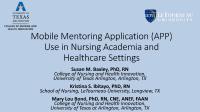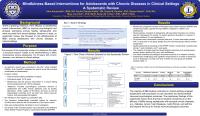| dc.description.abstract | Session presented on Friday, July 24, 2015: Purpose: The purpose of this pilot study was to explore if nurses in academic settings at the undergraduate (Associate degree, diploma, BSN, RNnd BSN) and graduate (Master's, PhD, DNP) levels and in healthcare settings would perceive the concept of a mobile application (APP) as useful in the mentoring relationship.Mentoring makes a difference in people's lives and has a different meaning, depending on the relationship (Baxley, Ibitayo & Bond, 2014). Mentoring in nursing, while not new often has many different definitions. Global mentoring is a 'reciprocal, mutually beneficial relationship between a mentor and a protege that challenges and is based on trust, communication, respect and cultural influences' (Baxley, Ibitayo, Bond, 2014, p. xxxvii). While skeptics have questioned the value or practicality of new technology, these technologies are allowing individuals to interact and communicate quickly. Technology effects how we conduct our professional and personal lives in profound ways (Guy, 2002) and the communication in mentoring is human, interpersonal and value laden. Technology is altering the human connections in significant ways. This presentation will first describe Baxley and Ibitayo's Mobile Application Acceptance Model (2014), in which the Mentor and protege each independently assess their Technology Self-efficacy (TSE) as they may have different levels of comfort and self-efficacy when using technology. TSE then effects the mentoring dyad's Behavioral Intention to Use (BIU), or else passes through the medium of Perceived Ease of Use (PEU) and Perceived Usefulness (PU). PEU is determined by the dyad's perception of ease to use and work with technology and directly affects either PU or the Mobile APP Attitude (MAA). PU is determined by the dyad's perception of technology improving performance and productivity, and is influenced by PEU and TSE. PU can either directly affect Behavioral Intention to Use (BIU), or first pass through the medium of the Mobile APP Attitude (MAA). Behavioral Intention to Use (BUI) influences actual use (AU) of the mobile mentoring app. Based on the model, the findings from a pilot study of nurses and nursing students in four countries (United States of America, Australia, Brazil, and Canada), who examined the perceived acceptance and perceived use of a mobile app for mentoring will be presented. Design: The design of the study was exploratory, descriptive. Methods: E-mail invitations were sent to STTI chapter presidents to request that they send it to their members. The e-mail explained the purposes of the study and a link to obtain the consent and the survey. The survey contained a link to a demonstration of the mobile mentoring APP which they reviewed and then answered the survey questions in Qualtrics (2014). The survey included demographic information and questions to measure technology self-efficacy, behavioral intention to use, perceived ease of use, perceived usefulness, and mobile app attitude. A quota sampling was used to obtain a representative number of participants from nurses in academia and nurses working in healthcare facilities. One hundred fourteen nurses from academic settings and healthcare settings provided data to answer the research questions. The participants ranged from 23-70 years of age, mostly Caucasian (79.8 %), and female (83.4%). Thirty percent were students, with 13.2% being in a Master's program and 13% in doctoral programs. Most of the participants stated that they used some type of technical device (laptop, smart phone, Kindle) and those in academia mostly used educational software associated with teaching. They were not as familiar with the use of applications for education. Results: After reviewing the prototype of the mentoring APP, the participants rated whether they considered themselves as skilled mobile device users. Sixty percent noted they were skilled users with 33% not answering the question and 15% stating they were not skilled. This trend in the results continued with questions relating to confidence in communicating, obtaining information, accessing the inteRN, and using an app. While the participants were positive toward a mobile application for mentoring (51%), only 34% agreed they would positively use a mentoring app (34%). While they were positive towards the app and use, conceRNfor communication showed only 30% who agreed or strongly agreed but they thought it was an ethical means of communication (46%). They answered positively that the mentoring app would improve their mentoring relationship (42%), would increase communication (48%) and make it easier to give assistance and guidance (48%). Conclusions: The idea of a mentoring application for mentoring showed positive feedback for the majority of the participants but those who were not familiar with applications or used the inteRN rarely, were not interested in using it. These individuals were mostly older, ages 45-70 and some were retired. On the questions of ethical conceRNand intention to use, the results showed more indecision or noted that it would depend on whether the mentor and protege were both comfortable with technology. More research is needed with the actual use of a mentoring application. This would provide information from participants related to their actual experience. | en |





